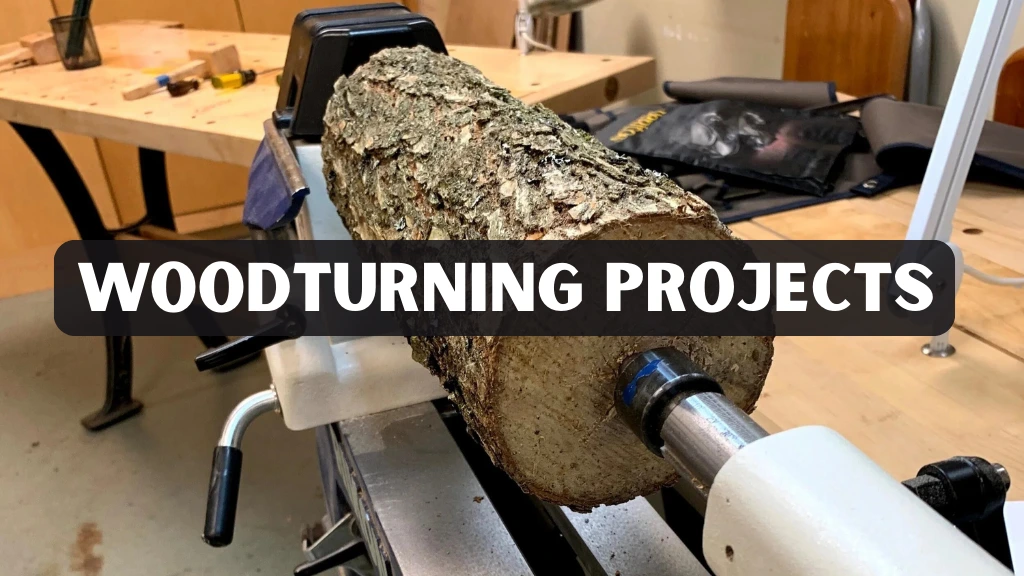Woodturning is a captivating craft that transforms simple blocks of wood into functional and decorative pieces using a lathe. Whether you are a novice eager to start or an experienced artisan seeking fresh ideas, this guide provides detailed instructions, practical tips, and inspiration for various woodturning projects. Woodturning combines precision, creativity, and craftsmanship, making it a favorite among woodworking enthusiasts worldwide. The skill can be applied to create everything from practical kitchen utensils to intricate decorative pieces, and it continues to be a popular woodworking discipline because it blends artistry with functionality.
Understanding the Art of Woodturning Projects
Woodturning involves shaping wood by rotating it against a cutting tool. This technique allows artisans to craft a wide variety of items, ranging from simple, everyday tools to elaborate decorative objects. The versatility of woodturning projects makes it accessible for both beginners and advanced woodworkers. When starting, it is essential to select the right type of wood and mount it securely on the lathe. Softwoods like pine or basswood are easier for novices, while hardwoods such as maple or cherry are preferred for advanced work due to their durability and fine grain.
The process begins with the wood being held firmly on the lathe, allowing it to spin at controlled speeds. Turning tools, including gouges, scrapers, chisels, and parting tools, are used to carve, shape, and hollow the wood. A skilled woodturner can produce items such as bowls, pens, furniture legs, ornaments, and even sculptural pieces. The appeal of woodturning lies not only in the final product but also in the meditative rhythm of shaping wood, the satisfaction of seeing a rough block transform into something elegant, and the pride of crafting items that are both functional and beautiful.
Essential Tools for Woodturning
Having the proper tools is essential for completing woodturning projects successfully. The lathe is the heart of any setup, with mini versions suitable for small-scale projects and full-size lathes designed for furniture components. Experienced woodturners emphasize choosing a reliable lathe from trusted brands, as stability and precision directly affect the quality of finished work. Safety gear, including face shields, dust masks, and ear protection, is non-negotiable to prevent injuries and maintain a safe workspace.
Turning tools such as gouges, scrapers, chisels, and parting tools are equally important. Experts recommend using high-quality tools with comfortable handles and well-maintained blades to achieve smooth cuts and fine details. Proper technique, guided by tutorials from reputable sources or professional instructors, ensures both safety and excellent results. Measuring instruments like calipers, rulers, and squares allow woodturners to maintain uniform dimensions, a crucial factor when crafting multiple items or complex components.
Finishing supplies complete the toolkit, including sandpaper, sanding blocks, and protective oils or varnishes. Trusted resources like woodworking books, magazines, and online platforms provide guidance on selecting finishes suitable for different wood types and project purposes. Maintaining an organized, well-lit workspace improves efficiency and reduces errors, ensuring projects are both enjoyable and reliable. Following these expert recommendations builds confidence, skill, and high-quality craftsmanship in every woodturning endeavor.
Beginner-Friendly Projects
For beginners, starting with simple projects is the best way to build foundational skills without becoming frustrated. Creating wooden spoons and spatulas is an ideal entry point. These practical kitchen items provide an opportunity to practice basic shaping and carving techniques. Softwoods like pine or basswood are recommended because they are easier to work with, forgiving for novice mistakes, and allow for smooth finishes.
Another approachable project is making small bowls. These items help beginners learn hollowing techniques while developing a sense of depth and wall thickness. Experimenting with different shapes and wood types can also lead to unique designs, even for simple bowls. Coasters are another excellent beginner project. They are flat, small, and simple to shape, making them perfect for honing precision and symmetry skills. Personalization through engraved designs or decorative burn marks can make these coasters a charming gift.
Compact items such as pens and pencils also serve as beginner-friendly projects. They require fine control and precision, offering a chance to practice detailed turning. These small-scale items are ideal for learning how to handle tools delicately while producing professional-looking results. Starting with these projects allows beginners to gain confidence, practice basic techniques, and enjoy tangible results early in their woodturning journey.
Intermediate Woodworking Projects
Once basic skills are mastered, woodworkers can move on to more intricate and functional items. Candle holders, for example, combine decorative appeal with practical use. Experienced artisans recommend experimenting with grooves, rings, and varying heights to refine shaping techniques. These projects help build confidence and prepare woodturners for more complex challenges.
Vases and cups introduce advanced hollowing techniques and require careful attention to curves and wall thickness. Experts suggest using different wood species to add visual interest, while subtle textures or decorative patterns allow for creative expression. Rolling pins and other kitchen utensils provide practical, hands-on experience, demanding precise measurements and meticulous sanding for smooth, professional finishes.
Custom tool handles are another rewarding intermediate project. Crafting ergonomic and decorative handles enhances everyday tools while developing fine control over shaping techniques. Professionals highlight the importance of exploring different woods, finishes, and design elements, as this deepens both skill and artistic creativity. Intermediate projects effectively bridge beginner practice and advanced craftsmanship, fostering confidence and technical mast
Advanced Projects for Skilled Woodworkers
Advanced woodturning projects push creative and technical boundaries. Crafting table legs or furniture components requires precise measurement, structural understanding, and attention to detail. Woodworkers must account for grain direction, balance, and uniformity to ensure the finished pieces are both beautiful and functional.
Segmented turning is another advanced technique. This involves joining multiple pieces of wood to form intricate patterns and designs. Proper alignment, cutting precision, and careful gluing are essential to create visually stunning results. Hollow forms and sculptural pieces represent some of the most challenging yet rewarding projects. These items demand patience, advanced hollowing techniques, and a high degree of creativity.
Custom gifts, such as jewelry boxes or ornaments, also fall into the advanced category. These projects allow for intricate detailing, personalized touches, and unique designs that showcase craftsmanship. Advanced projects not only demonstrate technical mastery but also offer opportunities for artisans to express their creativity in highly polished, professional-quality pieces.
Case Study Transforming a Hobby into a Small Business
Jessica, a hobbyist woodturner from Oregon, started creating simple wooden spoons and coasters in her garage. Initially, her goal was personal enjoyment and gifts for friends and family. Over six months, she refined her skills by experimenting with different wood types, finishes, and decorative patterns.
By documenting her projects on Instagram and YouTube, Jessica attracted a small following of woodworking enthusiasts. Her tutorials and visually appealing creations demonstrated both craftsmanship and creativity, building trust within the community. She soon began receiving orders for custom bowls, pens, and ornaments, turning her hobby into a profitable small business.
Jessica’s success highlights the importance of consistent practice, attention to detail, and leveraging online platforms to showcase your work. Her journey illustrates how mastering beginner and intermediate projects can pave the way for advanced creations and commercial opportunities. Woodturning is not only a creative pursuit but also a viable avenue for entrepreneurship.
Tips for Successful Woodturning
Starting with softwoods is recommended for beginners because they are easier to shape and less likely to cause damage to tools. Maintaining sharp tools is essential to achieving smooth finishes and reducing the risk of accidents. Regular practice helps refine skills and build confidence, while prioritizing safety ensures a pleasant experience and long-term health.
Applying finishes carefully is another critical aspect of successful woodturning. Sanding progressively from coarse to fine grit produces a flawless surface, and choosing the appropriate finish whether oil, wax, or varnish protects the wood and enhances its natural beauty. Food-safe finishes are particularly important for kitchen items like spoons and rolling pins. Consistency, patience, and attention to detail are key to producing professional-quality results.
Woodturning Resources and Communities
Engaging with resources and communities enhances learning and provides inspiration. Online forums such as Reddit and woodworking Facebook groups host active discussions where members share tips, project ideas, and troubleshooting advice. Local workshops and classes offer hands-on experience under the guidance of experienced instructors. Video tutorials on platforms like YouTube allow learners to see step-by-step processes and techniques, providing visual guidance that complements written instructions.
Books and magazines like American Woodturner and Woodturning Magazine provide in-depth articles, project plans, and expert tips. These publications often feature both traditional and contemporary techniques, allowing woodworkers to expand their knowledge and stay updated on industry trends. For a comprehensive historical and technical overview, visit Wikipedia’s Woodturning Page.
Conclusion
Woodturning projects offer a fulfilling combination of creativity, craftsmanship, and practical skill. Starting with beginner-friendly items like spoons, bowls, and coasters builds foundational skills, while intermediate and advanced projects provide opportunities to explore hollowing, shaping, and decorative techniques. From functional kitchen utensils to intricate sculptural pieces, woodturning allows artisans to produce items that are both beautiful and useful.
Consistent practice, attention to safety, and engagement with communities or resources ensure long-term growth and skill development. Exploring different wood types, finishes, and design approaches encourages creativity and expands the possibilities of what can be achieved on the lathe. Whether for personal enjoyment, gifts, or commercial purposes, woodturning is a versatile craft that rewards patience, creativity, and dedication, resulting in handcrafted pieces of lasting value.
FAQs
What type of wood is best for beginners?
Softwoods such as pine, basswood, and poplar are ideal for beginners. They are easy to shape, forgiving for mistakes, and produce a smooth finish without excessive effort.
Can I sell items I make from woodturning?
Yes. Handmade wooden products are popular for gifts and can be sold online, at craft fairs, or through local retailers. Woodturners often find that personalized items or functional pieces like bowls and pens are particularly in demand.
Is a lathe required for all projects?
Most traditional wood projects require a lathe to achieve precise and uniform shapes. Some decorative projects can be carved by hand, but a lathe ensures consistency and efficiency.
How do I maintain my turning tools?
Regular maintenance includes keeping blades sharp, cleaning off dust and resin, and checking handles for stability. Proper care extends tool life and improves performance.
How do I achieve a smooth finish?
Sand progressively from coarse to fine grit, then apply a suitable finish such as oil, wax, or varnish. Food-safe finishes are recommended for kitchen items, while decorative items can benefit from varnish or polish for aesthetic appeal.




